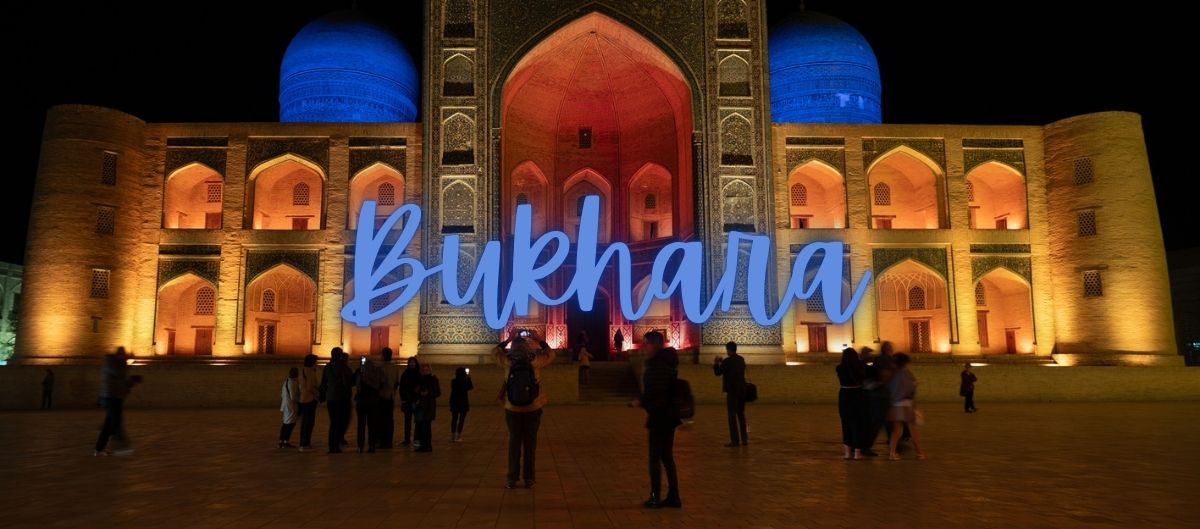Fairy Tales, Poets and Silks: My Love Affair with Bukhara

Bukhara, the country’s oldest and continuously inhabited cities a major center of trade, scholarship, and religion on the Silk Road for over two millennia. Today, it’s known for its remarkably preserved Islamic architecture, old city atmosphere, and its role as a spiritual and intellectual heart of Central Asia.
Over 2,000 years old: Bukhara’s roots go back to the 6th century BCE, long before Islam arrived, as part of the Persian Empire, and later under Arab, Mongol, and Turkic rulers.

Where to visit and what to look for…
Itchan Kala, Old City Core
A walled city of over 140 preserved historic buildings. Think minarets, madrasahs, mosaics, and mosques with glowing turquoise tiles.






The Ark Fortress
An ancient citadel that once housed Bukhara’s emirs and includes museums, royal chambers, and panoramic views. The Ark Fortress is one of the most interesting of Bukhara’s historic buildings. Its foundations were laid in the 4th – 3rd centuries BCE. Destroyed and rebuilt, it had served as Bukhara rulers’ residence until the 1920’s Soviet bombardment.

Po-i-Kalyan Complex
The iconic Kalyan Minaret, mosque, and religious school ensemble. The minaret dates back to 1127 and survived Genghis Khan’s destruction. And the Kalon Mosque, large enough to hold 10,000 people!






Lyabi Hauz
My favorite…a peaceful square around a reflecting pool, lined with cafes and old madrassas.


Samanid Mausoleum
One of the oldest and most important monuments of Islamic architecture in Central Asia. Built in the 10th century, it served as the final resting place of Ismail Samani, the founder of the Samanid dynasty. Made entirely of baked brick, the mausoleum showcases intricate geometric patterns and clever use of light and shadow—considered revolutionary for its time.
Its perfect cube shape topped with a dome symbolizes the link between earth and heaven.



Sitorai Mokhi Khosa Palace
A magnificent royal residence just outside Bukhara, and one of the region’s most enchanting architectural treasures. Often called the “Palace of the Moon and Stars,” it was the summer palace of the last Emirs of Bukhara, offering Eastern opulence and Western aesthetics. Carvings and staggering details along with european windows, chandeliers and a lengthy ballroom worthy of Versailles.







Bukhara has long been known for its craftsmanship, especially its Suzani embroidery
Because it’s not just about the sights — it’s the atmosphere.
Bukhara is a special Uzbek travel memory for me, thanks in part to my charming hotel stay at the Komil Bukhara Boutique Hotel. The house on Barakiyon (Arabon) Street, where Komil Bukhara Boutique Hotel now stands, was built over a century ago as the residence of one of Bukhara’s wealthiest merchants.
Richly decorated with intricately carved woodwork and hand-painted interiors, it exemplified elite Bukharan craftsmanship and design. About 50 years ago, the property was purchased by Komil’s grandfather, beginning its transition from private residence to hotel and a short walk from the Lyabi-Hauz ensemble and tucked down a quiet street off the domed bazaars.







Bukhara is a place where history lives on: in the call to prayer echoing through ancient streets, in the tea shared by a carpet seller, in the soft light on weathered bricks.
Related Posts
Captivating Khiva: An Astonishing Life Inside the City Walls
Khiva’s roots stretch back over 2,500 years, but its golden age began in the 16th …
June 7, 2025The Quiet Magic of The Turkmen: Nomads of the Steppe
Nestled in Uzbekistan’s remote northwest, Urgench might not be the first name that jumps out …
June 7, 2025

Leave A Comment